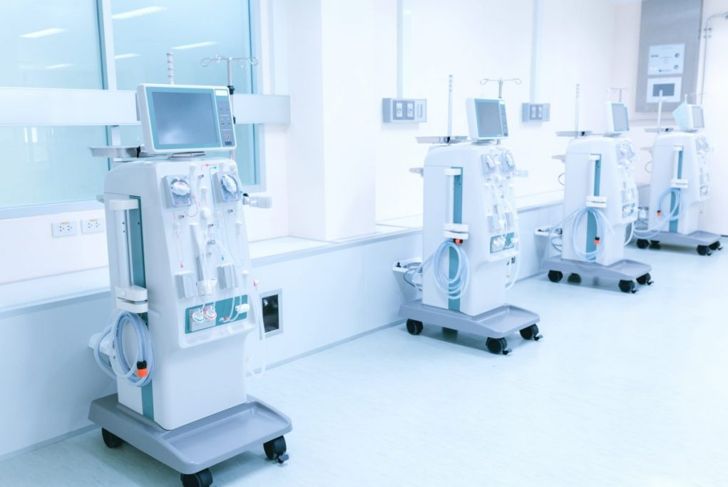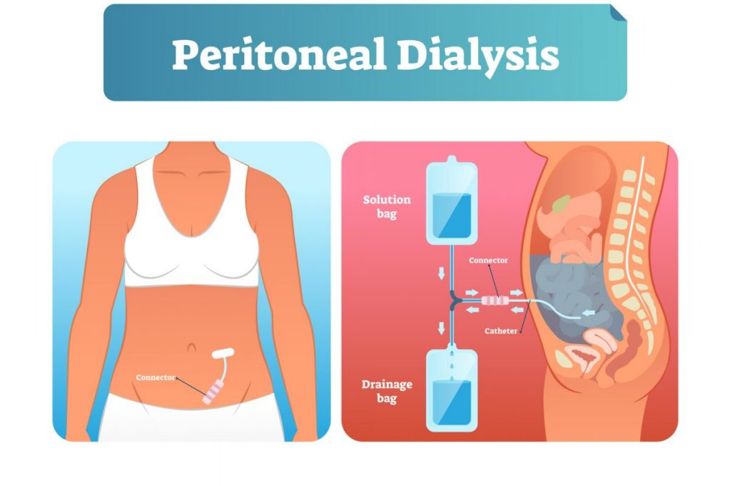The kidneys perform many functions to keep the body healthy. Not only are they responsible for overall fluid balance, but they also remove waste products and excess fluids through the production of urine. Humans have two kidneys, and each one is about the size of a fist. People with diabetes, high blood pressure, and a family history of kidney disease have a higher risk of developing a kidney condition. If the kidneys fail, an individual may require dialysis treatments to take over the function of this vital organ.
Signs of Kidney Failure
Kidney disease is a chronic condition. A constant buildup of excessive amounts of urea and other wastes is a primary symptom of kidney failure. A glomerular filtration rate (GFR) diagnostic test measures kidney function. If the GFR is 15 milliliters or less, or the individual loses about 85 to 90 percent of kidney function, the kidneys are failing. People with kidney failure experience swelling throughout their bodies due to fluid buildup. Other symptoms include nausea or vomiting, a metallic taste in the mouth, severe itching, and fatigue. Some people lose their appetite and begin to lose weight. Others report having issues thinking clearly.
What is Dialysis?
Doctors prescribe dialysis when the kidneys are no longer able to filter the blood or remove harmful wastes, salt, and fluid to prevent buildup in the body. By controlling certain chemicals in the blood, such as potassium, sodium, and bicarbonate, dialysis also helps control blood pressure. It is not a cure for kidney disease. A kidney transplant is the only option that prevents further dialysis treatments. There are two types: hemodialysis and peritoneal dialysis.
Hemodialysis
The most common method of dialysis is hemodialysis. A hemodialyzer machine or artificial kidney removes waste, excess fluids, and chemicals from the body by filtering the patient’s blood through the machine. A doctor will perform minor surgery to create access to the individual’s blood vessels through one of three methods. The preferred method is an arteriovenous (AV) fistula, but other options include a looped tube — an AV graft — or a vascular access catheter, which the doctor inserts into the large vein in the neck. These are long-term treatment methods.
Length of Hemodialysis Treatments
Doctors prescribe the frequency and length of hemodialysis treatments based on the patient’s body size, health conditions, and the amount of waste that requires removal. In most cases, patients undergo hemodialysis three times a week for three to five hours. High-flux dialysis is sometimes an option and offers a shorter treatment time. A hospital, dialysis unit, or doctor’s office are the most common sites for these treatments. However, patients undergoing treatments for an extended period may have the option to receive dialysis at home.
Peritoneal Dialysis
Instead of treating the blood outside of the body using a machine, peritoneal dialysis cleanses the blood inside the body. The physician surgically inserts a soft catheter tube into the abdomen to create an access point. The peritoneal cavity contains a fluid called dialysate, a solution comprised of water, electrolytes, and salts. The fluid helps filter harmful toxins from the blood into the dialysate but prevents the helpful materials from leaving the blood. There are several different types of peritoneal dialysis, but the two primary types are continuous ambulatory peritoneal dialysis (CAPD) and automated peritoneal dialysis (APD).
Continuous Ambulatory Peritoneal Dialysis (CAPD)
With CAPD, patients can go about their normal daily routines: the treatment requires no machine. Instead, a bag containing two quarts of cleansing fluid releases the fluid through a catheter into the abdomen. Then, the patient drains the fluid back into the bag and discards it. Patients perform CAPD treatments between three and five times per day. Each treatment takes between 30 and 40 minutes. This type of treatment allows patients to attend work or school around their dialysis treatments.
Automated Peritoneal Dialysis (APD)
Some patients prefer APD because a machine performs the treatment while they sleep. CAPD and APD require the same number of cleansing fluid exchanges, but APD occurs overnight. Once the individual wakes up the next morning, they must fill the peritoneal cavity with the dialysate. It remains there for the remainder of the day until the nightly fluid exchanges. According to studies, some patients choosing APD say they have more time for work, family, and social activities than what is possible using CAPD.
Peritoneal Dialysis Complications
Like any other medical procedure or treatment, peritoneal dialysis may develop complications. Peritonitis is a bacterial or fungal infection that introduces harmful bacteria into the peritoneal cavity and infects the tissue that lines the inner abdominal wall. Doctors prescribe antibiotics to treat the infection, but serious infections may require surgery. Studies show that APD causes fewer infections than CAPD, resulting in fewer hospital admissions for APD patients. Both APD and CAPD are at equal risk for infection around the site of the catheter. It is essential patients practice good hygiene.
Dialysis and Diet
When an individual is receiving dialysis treatments, the physician or a renal dietician will provide a special diet plan that helps reduce the amount of waste buildup in the body. The person must avoid foods high in potassium, phosphorus, and sodium. Vegetable juices and sports drinks, for example, are high in sodium. Limiting fluid intake, including soups, gelatin, ice cream, and puddings, is also important. Excess fluid buildup can cause difficulty breathing, severe blood pressure changes, and heart issues. Health care professionals weigh the patient after each treatment to determine their dry weight. Prior to the next dialysis treatment, they weigh the individual to determine the amount of fluid that requires removal during the treatment to reach the patient’s dry weight.
Additional Facts About Dialysis
Dialysis treatments are not normally painful. Some patients report headaches, cramps, nausea, and vomiting during treatments, but this is typically the result of a drop in blood pressure. Individuals who have a higher volume of fluid during the treatment are more likely to experience blood pressure drops, so sticking to a physician-recommended diet plan is important. Nearly 500,000 people in the U.S. receive dialysis. Although it is not a cure, it does provide effective, lifesaving treatment for those with kidney failure. In some cases, a physician may discuss a kidney transplant if the patient’s health is stable enough.

 Home
Home Health
Health Diet & Nutrition
Diet & Nutrition Living Well
Living Well More
More




















